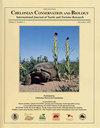嗅觉作为海龟筑巢地点选择的线索
IF 0.8
4区 生物学
Q3 ZOOLOGY
引用次数: 9
摘要
海龟的巢址选择对其适应性有显著影响。以前关于筑巢地点选择的研究主要集中在可能影响筑巢地点选择的环境因素上(例如,温度、日照、土壤类型或湿度)。在内布拉斯加州沙丘的新月湖国家野生动物保护区,对彩龟筑巢的观察表明,雌性可能会使用嗅觉线索(特别是其他筑巢雌性的气味)来选择筑巢地点。我们使用arcmap10.1中的最近邻(巢)距离算法间接验证了这一假设。我们在2012-2014年对巢的调查结果好坏参半,有些海龟在某些年份的某些地点筑巢,有些海龟非随机地出现在离以前的巢很近的地方。2015年在主要筑巢区使用尿液处理过的地方进行的初步实验数据也表明,雌性对这些地方的兴趣比用同样数量的水湿润的地方更大。这些数据为巢气味作为海龟选择巢址的重要线索提供了一些支持,但它们不足以拒绝同时使用其他精细尺度环境线索的可能性。本文章由计算机程序翻译,如有差异,请以英文原文为准。
Olfaction as a Cue for Nest-Site Choice in Turtles
Abstract Nest-site choice in turtles has a demonstrated impact on their fitness. Previous studies of nest-site choice have focused on environmental factors potentially affecting that choice (e.g., temperature, insolation, soil type, or moisture). Observations of nesting of painted turtles (Chrysemys picta) at the Crescent Lake National Wildlife Refuge in the Nebraska Sandhills suggest that females might use olfactory cues (specifically odors of other nesting females) to choose nest sites. We tested this hypothesis indirectly by using the nearest neighbor (nest) distance algorithm in ArcMap 10.1. Our results for nests in 2012–2014 were mixed, with nesting at some sites, in some years, and by some turtles occurring nonrandomly, in very close proximity to previous nests. Preliminary experimental data from 2015 using urine-treated sites in primary nesting areas also suggested that females showed more interest in those sites than sites moistened with equal amounts of water. These data provide some support for the use of nest odor as an important cue for nest-site choice in turtles, but they are insufficient to reject the possibility of the simultaneous use of other fine-scale environmental cues.
求助全文
通过发布文献求助,成功后即可免费获取论文全文。
去求助
来源期刊
CiteScore
1.70
自引率
14.30%
发文量
17
审稿时长
>12 weeks
期刊介绍:
Chelonian Conservation and Biology is a biannual peer-reviewed journal of cosmopolitan and broad-based coverage of all aspects of conservation and biology of all chelonians, including freshwater turtles, marine turtles, and tortoises. Manuscripts may cover any aspects of turtle and tortoise research, with a preference for conservation or biology. Manuscripts dealing with conservation biology, systematic relationships, chelonian diversity, geographic distribution, natural history, ecology, reproduction, morphology and natural variation, population status, husbandry, community conservation initiatives, and human exploitation or conservation management issues are of special interest.

 求助内容:
求助内容: 应助结果提醒方式:
应助结果提醒方式:


